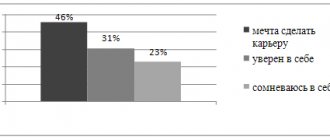Verbal and nonverbal communication are like two sides of the same process. You can say a lot with language and speech, but there are some moments that are best conveyed through body language. Knowing the possibilities of different forms of communication allows a lot. For example, to gain the favor of other people, to predict the consequences of one’s actions and their impact on others.
What it is
It is customary to distinguish two types of contact: through speech and facial expressions, body posture, touch, etc. Verbally means conveying information verbally. This means not only an oral conversation, but also a written one - through text in instant messengers.
This also refers to internal dialogue, when a person communicates with himself. For good verbal communication, an individual must develop his thinking, increase his vocabulary, and read a lot of books.
Important! When writing, you need to follow the rules of the Russian language, since illiterate text causes unpleasant emotions.
In psychology
It is believed that people can communicate most effectively through a sign system, i.e. language. It is with its help that a person can think, i.e. putting images into words.
Speech allows:
- Find the meaning of phenomena;
- Understand the event;
- Express feelings;
- Indicate your position and worldview.
Personality, consciousness and language are connected and cannot exist separately. Problems arise when speech is used incorrectly. In psychology, several functions of verbal communication are distinguished: interaction between individuals, receiving and transmitting information, displaying accumulated knowledge, expressing feelings.
Verbalism is the ability to unite on different grounds. For example, people of the same nationality speak the same language, this allows them to gather in one group.
Methods of nonverbal communication
The most popular non-verbal communication tools are gestures and facial expressions. Hands and face are the most “emotional” parts of the body, and the most mobile, as a result of which they are more expressive when speaking. The expression of emotions is perhaps the main content of the “conversation” when gesturing. Verbal communication is not always capable of conveying the emotional component of information, and this ability varies in different “sound” languages. In this case, the hands and face are connected. Especially if the conversation is conducted by “hot” and sensual people.
Additional ways of nonverbal communication are postures and touch. Such body movements can also tell a lot about a person, his thoughts and attitude to what is happening.
Even the distance between interlocutors can say a lot about the participants in the conversation.
So, there are types of maximum permissible distance depending on the circumstances of the conversation
:
- Intimate distance – up to half a meter
. This is how interlocutors talk, who trust each other to the maximum extent and are ready to share their most intimate things. In particular, lovers stand very close to each other. Best friends also communicate at the closest possible distance. At such a distance, physical contacts and touches are possible, which also reflect the closest, most trusting and intimate relationships possible. - Interpersonal distance – from half a meter to 1.2 meters
. At such a distance, ordinary friends, acquaintances, and close acquaintances conduct a friendly conversation. Touching may also be allowed here, although such strong bodily contacts as in the first case are not possible. - Social distance – from 1.2 to 3.7 meters
. It is intended for informal interaction in society, during a business meeting. The greater the distance, the more formal the conversation. It goes without saying that touching at such a distance is no longer possible. - Public distance is more than 3.7 meters
. This is the most appropriate distance for a lecturer speaking to a large group of people.
The distance during a conversation also depends on the gender, age, and personality characteristics of a person. Thus, young children are most comfortable communicating at close range, while teenagers prefer to distance themselves. A woman prefers a closer distance, regardless of the gender of her interlocutor. Confident people do not pay much attention to distances, while anxious people tend to be away from their interlocutors. Powerful people tend to shorten the distance when talking, to push - this is where, apparently, the word “assault” comes from.
Visual contact is also an important source of information. Vision is the main sense organ for humans; with its help, we strive to obtain maximum information about the subject that interests us. Therefore, long eye contact means admiration for the interlocutor, if the gaze is calm. A gaze with raised eyebrows signifies anticipation. And an intrusive, gaze with a somewhat alarming expression means indignation. If a person “rolls” his eyes, looks away, and avoids eye contact in every possible way, this means that the interlocutor is unpleasant to him.
Gestures and postures tell about people's feelings and attitudes. Their manner of sitting, standing, and the placement of their hands are important. For example, a positive position is recognized when the interlocutor sits with the body slightly tilted forward, with the hand slightly touching the cheek. Criticism is expressed by a characteristic gesture: one hand is at the chin, the index finger is extended along the cheek, the second hand supports the elbow of the first. If there is distrust, the interlocutor covers his mouth with his palm. Superiority is expressed by a sitting position, one leg placed on the other, arms thrown behind the head, eyes slightly closed. When disapproving, a person “shakes off the lint,” straightens his clothes or shakes them off, his movements are convulsive and restless.
Rubbing the chin, forehead, and bridge of the nose are known indicators of concentration. The eyes may be closed. Outstretched arms, straight head, relaxed body indicate the openness of the interlocutor.
Facial expressions are also important. It can tell about both a person’s thoughts and his feelings, while different halves of the face carry different information. As you know, the left hemisphere of the brain is responsible for intelligence, which controls the right side of the face; The right hemisphere of the brain is responsible for emotions and controls the left side of the face.
Anger is expressed by wide open eyes, while the gaze is “squinted”, the teeth are clenched, and the corners of the lips are lowered. Raised eyebrows and a slightly open mouth mean that a person is surprised. Closed eyebrows, stretched lips with downturned corners indicate that the interlocutor is scared. A calm look with raised corners of the lips means the interlocutor is happy. Lowered lips and a “faded” gaze indicate sadness.
Even the intonation and timbre of the voice carry their own layer of information. Thus, drawn-out pronunciation of words and monotonous intonation are characteristic of an arrogant person. Clear, confident speech and a high tone of voice indicate enthusiasm and elation. A low tone of voice and a decrease in volume towards the end of a sentence indicate fatigue; Excitement is conveyed in the same way, but the speech is faster and the statements are abrupt. If there are many pauses in speech, the interlocutor coughs, or makes mistakes in words, it means that he is demonstrating uncertainty.
How to use
Verbal communication - what is it in psychology
Nonverbal and verbal communication exist together. A person usually does not think about what and how he uses, since all processes occur unconsciously. For example, experts have established that an individual can use 3,000 words per hour.
There are special exercises that can make communication effective
Verbal interaction is based on two principles: a set of words and rules for creating phrases. The processes of thinking and speech are inseparable, so communication occurs approximately according to the following scheme:
- The speaker selects words and then mentally forms a statement.
- Says the phrase out loud.
- The interlocutor perceives the information and prepares a response statement.
When communicating verbally, clarity of phrase is important. Even if it is pronounced correctly, another person may interpret it incorrectly. A grammatically formatted sentence is easier to understand, especially in written form.
In order to understand what a verbal method of communication is, you need to know all the features of the process. Not only words have meaning, but also voice modulation, rhythm, intonation, pauses. In writing, the tilt and pressure of the pen is important. Such signs do not appear in printed text.
Secrets of success in business verbal communication
Negotiations are an integral part of running any business. It is there that partners negotiate deals, sign contracts, etc. Your success and profitability of your business will largely depend on how well you know how to communicate, convey your point of view, and convince. Essentially, if you have good verbal business communication skills, then the business will flourish and generate income.
Equally important is the ability to inspire everyone around you with your ideas and enthusiasm, family members, team members, even your bosses. It's good if you can consider short-sighted decisions and dissuade people from implementing them. In essence, this is the foundation of verbal business communication.
Even ancient people at some point realized that reaching agreement on controversial issues was possible not only through military action. Yes, with spears and arrows you can easily get rid of dissenting opponents, subjugate the weak and force them to work for you, but in the heat of the struggle, your loved ones will also die. It is possible that at one time a simple survival instinct worked, but the person realized that negotiations, especially those conducted competently, are much more effective in helping to solve problems.
You can give a lot of examples of what methods people resorted to in negotiations at one time or another. Someone was waving a pistol left and right, and there were entire groups that sought influence by force. Somewhere in the far East, a joker walked around an old bazaar who, thanks to his sharp mind and sense of humor, was able to resolve any unexpected conflict. And the wise decisions of King Solomon will forever remain in history as the most competent and far-sighted.
- Masterfully conducted negotiations are half the success of any business
We can talk about competent technology for building verbal communication forever; this is an important and often discussed topic. And the issue of improving negotiation skills always remains relevant.
Where to gain this skill? It will appear with experience, here you should constantly practice, analyze mistakes (both your own and others), and learn lessons. Of course, the desire to learn and improve is important here. First, you study the issue theoretically, then train in the practical use of the acquired knowledge, evaluate the results, correct weak points, and then do it all over again. Work, work and more work. This is the only way you will gain serious skills, hone your skills in verbal communication and be able to negotiate competently and effectively.
In fact, you can work on improving your negotiation skills throughout your life; there are no limits or restrictions. With new acquired experience, you only hone your own skills even better.
No matter how much experience a person has in negotiating, there is no limit to perfection. Anyone who believes that they have reached the pinnacle of mastery in this matter simply does not want to continue to develop. You can and definitely need to constantly hone your skills.
- What makes a successful negotiation
To achieve high skill in negotiations, you should not only learn the basics of verbal communication, but also constantly improve your own skills.
What are the components of successful negotiations? Everything is important here, the smallest details, including sounds, smells, taste, color perception and the form of contact with the interlocutor. In the process of communication, this is reflected in the words spoken, the gestures a person uses, facial expressions, voice intonation, etc.
There are certain foundations for the formation of verbal communication, on which any negotiations are built. Сommunico translated from Latin means “I make it common, I connect, I communicate.” That is, the essence of communications is to establish a connection between people, to establish a stable, understandable and accessible exchange of messages for both parties.
In the process of communication, information is transformed from verbal to non-verbal form or in the reverse order.
In simple terms, information that exists in the head of one of the interlocutors is transmitted to another (one or more) using some verbal or non-verbal signals. And here it is important that these signals are as clear as possible. Then we can assume that communication was built correctly and the negotiations were successful. If we use the terminology of professional psychologists, then receiving and assimilation of information is called internalization, and giving information to others is called exteriorization.
It is not always possible to establish communication in such a way that the channels of output and input of information perfectly correspond to each other. Here you should pay attention to how the interlocutor reacts non-verbally to messages, what his internal state is at the time of receiving them. A person can be surprised, show joy, anger, agree or disagree, etc. And these reactions are expressed in the form of verbal signals, that is, some exclamations, phrases.
The functions of verbal communication are not to simply give or receive information, but to build a common process that is meaningful for both parties. That is, it is important that one participant in the communication expresses his thought, and the other hears it, realizes and accepts it.
Effective communication is precisely built on the fact that the parties first exchange information, digest it, and then together comprehend the essence of the issue being discussed.
- Techniques for conducting effective negotiations
Every conversation begins with a greeting. To do this, you can use different phrases, for example, “Good morning!”, That is, you wish your interlocutor a good start to the day. Or a simple word “Hello!”, which implies a wish for health. The greeting question “How are you?” you show interest and seem to invite them to talk. Or you greet a person with the phrase “It’s so good that you came”, “I’m very glad to see you!”, which undoubtedly demonstrates your respectful attitude.
At the beginning of negotiations, these so-called emotional strokes are extremely important; they set the partner up for positive communication, as if they give confidence in advance that everything will go well and the interaction will be useful and fruitful for both parties.
Of great importance is such a moment as addressing the interlocutor by name. Always remember that one’s own name is something that a person is pleased to hear always and under any circumstances (after all, that’s what parents, family members and other close people call him). Use this fact in verbal communication. Be sure to address your interlocutor by name, and in no case make mistakes in his pronunciation (this is unpleasant and even offensive to hear), however, you should also not repeat the first name and patronymic too often, so as not to get an obvious overkill.
We recommend
“Sales scripts for managers: writing tips and application rules” Read more
Depending on how the negotiations are structured, you can add social strokes, expressed approximately in the following phrases: “You are immediately visible as a professional”, “Your subordinates praised you very much, and I see that it was not in vain”, “I have heard a lot about you” , “Your long-time partners highly recommended you to me,” “I heard that you always keep your promises.” This is very reminiscent of moments when a mother praises her child: “How good you are!”, “You are the best child in the world,” “I’m proud of you,” and so on.
Mikhail Dashkiev about Sergei Azimov
- The "Mirror" principle
The way you behave and communicate will certainly affect the people around you. Thus, by looking at the reactions of others, you can draw conclusions about what is wrong in your behavior, what people perceive as normal, and where changes would be helpful.
That is, in the process of verbal communication you receive feedback from others. They, like a mirror, reflect the results of all your words and actions, and you, in turn, give a verbal reaction to the behavior of your interlocutor and can thus control the course of negotiations.
It is important to convey to your partner information about how his behavior causes you to react. On the one hand, you can perceive his words and actions in a positive way, and therefore support the chosen line of negotiations. But you may not like what is happening, then you will have a negative attitude towards everything your partner says and make efforts to correct the situation and correct the behavior of your interlocutor.
All these are options for feedback when building verbal communication. You can show another, seemingly neutral, reaction, namely, tell your partner that he, of course, can have his own point of view, which, without a doubt, is professional and valuable, but your vision of the issue is still different.
Rules and types
Types of communication in psychology - what they include, its functions
Psychologists have been observing people for a long time, studying types of communication, and developing strategies for successful conversations. If you have a high level of intelligence, you can master them; this will be useful in everyday life.
Basic Rules:
- Kindness and respectful attitude are the guarantees of good communication.
- You cannot impose your point of view.
- Logic is observed in conversation, which means that statements must be consistent.
- Replies are kept short and clear.
- The age, nationality and religion of the interlocutor are always taken into account.
For successful communication, it is important to maintain a calm demeanor.
Important! You cannot insult, put pressure on, or humiliate a person - this causes a negative reaction.
Not everyone understands what verbal is: what kind of communication it is - oral or not. For such a communication process, both conversation and writing are used.
There are several types of verbal interaction: dialogue or monologue. The first requires the participation of one or more people who actively participate in the discussion. A monologue is a statement by one individual, usually voluminous in content.
There are two types of written speech: immediate and delayed. In the first option, communication takes place in real time, for example, in a chat or instant messenger. The second option involves receiving a response for a long time, for example, via email.
With dactyl speech, communication occurs through gestures
External speech will not exist without internal dialogue. The formation process cannot be simple, since the brain is involved.
Functions of nonverbal communication
Verbal communication refers to various ways of conveying information verbally or in writing. Nonverbal means of communication allow you to complement oral speech and give it more emotional colors. In some situations, nonverbal means completely replace verbal contact. As an example, we can cite silent films, where actors conveyed the essence of what was happening using body language. This art is called “pantomime”.
Also, nonverbal means of communication have the same set of functions as verbal ones. Every gesture and body movement allows you to convey information, express emotions and influence your interlocutor. Mastering this communication technique is quite difficult. With the main emphasis on the competent presentation of words and thoughts, most people completely forget about controlling their gestures. In some situations, words may completely mismatch body language. When a person talks about confidence, but his posture shows the opposite, the interlocutor tends to believe his body language.
This is why you should pay great attention to gestures when talking with other people. You should not try to hide your hands, as such a pose can be regarded as an attempt to close yourself off from your interlocutor. Open palms facing the interlocutor are a sign of trust. During business negotiations, you should try to stay as collected as possible and try to avoid relaxed or closed postures. In order to create comfortable conditions for conversation, you should calculate in advance the correct distance for conversation.
In order to master both communication techniques, you should develop qualities such as goodwill and confidence . Constant self-development allows you to reach a level where body language and speech complement each other.
Features of verbal communication
Functions of communication in psychology and their brief description
A person receives information from the world in different ways. One of these channels is verbal conversation. It is unique to humans. With verbal contact, more data is transmitted, but the process will always be accompanied by non-verbal signals.
There are different techniques that can make communication effective. They are actively used by marketers, salespeople, and businessmen. They can also be useful in everyday life.
Ways to make communication effective
The level of social skills does not depend on age. They are not given at birth, they need to be developed. Therefore, only through training can communication be made effective.
Understanding what it means to interact verbally helps you build relationships with people. To do this, you need to show interest in the interlocutor - this allows you to achieve goodwill.
It is better to talk about topics that are interesting to another person. For example, he works in the field of computer science, then you can ask about it. You cannot judge, criticize, or insult. Even during a discussion, one must adhere to the rules of politeness.
In order to understand what it is to communicate verbally, you need to practice a lot. During practice, you can practice clear pronunciation of words and phrases - this is necessary for understanding the text.
The rules of communication also apply on the virtual network.
It is worth avoiding psychological violence during interaction, as this causes negative emotions in the interlocutor. Positivity and openness are better for conversation.
In order to find out what verbality is, it is not necessary to create special conditions. This type of interaction is available to all people. With the right approach, this skill can be developed.
Techniques of business verbal communication
Remember the famous law of the jungle? It sounds like this: “You and I are of the same blood, you and I.” This is an excellent example of how to establish verbal communication, build dialogues and negotiate.
The effectiveness of communication will increase many times over if the interlocutor feels a kindred spirit in you, sees that your life values and priorities, although they do not completely coincide with his own views, are generally close and understandable.
This approach echoes the mirror principle discussed above. You reveal yourself to a person (“mirror”), and in response he willingly demonstrates (reflects) his attitude towards you, your behavior, actions, words.
In the modern world, this technique is actively used for conducting all kinds of negotiations and meetings. Such events are organized in suitable places (taking into account the interests of the participants), a relaxed atmosphere is created where, over a cup of tea or coffee (and perhaps a cigarette or stronger drinks), people have the opportunity to communicate freely and with pleasure.
And here the main thing is not to forget about the main goal of the negotiations. Do not put too much pressure on your partner or demonstrate excessive openness bordering on intrusiveness. In response, he may withdraw, and further communication will become difficult.
Experts in verbal communications identify four parallel levels at which, as a rule, the communication process takes place:
- A set of well-known stereotypes and templates (clichés).
- Real events and accurate facts.
- Opinions of communication participants, their own judgments and ideas.
- Emotional manifestations.
What are templates and clichés for? They make it possible to start and end a conversation correctly, and to build communication in accordance with generally accepted standards and norms. Yes, we are talking about stereotypes and memorized rituals, but it is with their help that you demonstrate to your interlocutor your openness, willingness to listen and accept the information being conveyed. At the beginning of a conversation, they usually ask a question, state their own point of view, or voice some important fact.
How to start a conversation? For example, use the so-called presence effect. Find something interesting to discuss in your surroundings and start talking about it (but don’t look around too openly, do it carefully, as if by chance).
Another topic for communication is the interlocutor himself, but such a conversation is more difficult to start. To push your partner to interact and get a response from him, you can use the following phrases: “Do you think I’m right?”, “What do you think about this?”, “Do you agree?” etc.
How else can you engage a person in a conversation? Talk about something interesting, about the events of your own life, a book you read, touch on any topic that can become the basis for pleasant communication.
An indispensable condition for effective verbal communication is genuine interest in the partner and his point of view. It is important for a person to see that you are truly interested in him, and then your interaction will be as productive as possible.
Emergence
Speech (articulate speech) appeared during human evolution between 1.7-2 million years ago, in the first homo - it was at this time that the speech apparatus was formed. According to anthropology, the main sign of the presence of a speech apparatus in a fossil individual is the styloid process of the temporal bone; it is rarely present in the skulls of Ardipithecus and is present in almost all skulls of early Homo. Speech is determined not only by the styloid process, but also by it, and it is easily identified in fossil remains[1].
According to Norwegian scientists Are Brean and Geir Skeie, the appearance of speech in the early stages of the evolution of Homo Sapiens
was preceded by communication using inarticulate sounds of a musical nature: rhythm, timbre, simple “melodies” and similar methods. This was facilitated by changes in the structure of the skull and mouth of hominids associated with the development of upright walking [2].
Scientists are increasingly inclined to the idea of a long and multi-stage evolution of speech with an increase in articulation, plurality of words and meaning, and complication of language structures[3]. The rise to each level was carried out naturally in connection with “self-domestication”[4], normativity, climate change, change of ecological niches, construction of new techno-natural niches and the formation of new social orders[5].
According to the Baldwin effect, gene-cultural coevolution and cultural drive, due to mass directed behavior and multi-level selection, genetic, neural, anatomical (larynx, respiratory muscles), psychophysiological (auditory and speech-motor) structures changed [6].
The development of abilities occurred thanks to everyday attempts to overcome mutual misunderstanding through rituals of altering sounds and guessing their meaning [7]. At the level of everyday communications, speech forms were selected, and individual selection, sexual selection, and intergroup selection also operated [8].
Notes
- Stanislav Drobyshevsky: The emergence of morality among people
- Breant, Skeie, 2022, p. 24.
- Bickerton D. Adam's language: how people created language, how language created people. M.: Languages of Slavic Cultures, 2012. Donald M. A Mind So Rare: The Evolution of Human Consciousness. New York: Norton, 2001. Rozov N. S. The origin of language and consciousness. How social orders and communicative concerns gave rise to language and cognitive abilities. Novosibirsk: Manuscript. 2022. 355 p.
- Belyaev D.K. About some factors in the evolution of hominids // Vopr. Philosophy, 1981. No. 8. P. 69 –77.
- Rozov N. S....2022, p. 60–62. Boyd R., Richerson P. Not by Genes Alone: How Culture Transformed Human Evolution. Chicago University Press, 2004.
- Boyd R., Richerson P. ...2004
- Rozov N.S....2022, p. 143–149
- Rozov N. S....2022, p. 155–158











